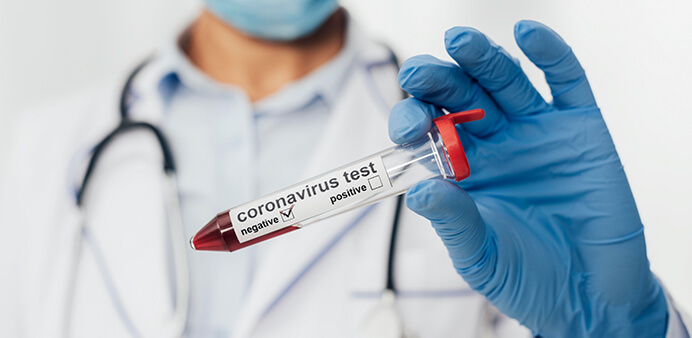
Can You Test Negative For COVID-19 and Still Have Symptoms?
As the UK faces yet another wave of COVID-19 with rising cases & hospitalisations across the length and breath of England, Northern Ireland, Scotland & Wales, people need to be mindful of the fact that for the first few days when they are experiencing COVID-19 symptoms, they can still produce a negative rapid test result.
So let’s take an up close look at this, & other different reasons, why some people test negative when they are really positive
RAT Test Kits Aren’t All Equal
The NHS states: “A negative result means it’s likely you’re not infectious. But a negative test is not a guarantee that you do not have COVID-19, and there’s still a chance you may be infectious. – No test is 100% reliable, even if it meets regulatory standards for performance & safety. – And the results are only relevant to the sample at that point in time [1, 2]
The two COVID tests which are used in the UK, are hugely different in their sensitivity. A PCR (polymerase chain reaction) test, which measures our body’s viral RNA, can detect as little as 200 copies of SARS-CoV-2 for each millilitre of sample. Conversely, a RAT (rapid antigen test), may not register positive if there are under 500,000 viral copies.
RATS
Rapid Antigen Tests come in different forms, with some being administered via the nostrils, and others via the mouth. Two of the most common mistakes people make is not reading the instructions carefully, or not following the testing procedure properly. If you think that you might have COVID-19, but after taking a rapid antigen test (RAT), find that you are still testing negative despite displaying symptoms, do you think that you should you be concerned? The answer to this is, “No!” – “The lower sensitivity of the RAT tests isn’t too much to worry about as we enter a new stage of the pandemic” [3]. But such tests are not all created equal, and you should ensure that you only purchase your test kits from a reputable supplier.
RATs still serve as crucial, easily accessible, detection tools, and if you can find a supplier that provides for the NHS, you can be assured that you are purchasing high quality products. These will be validated by Public Health England; be registered with MHRA, and be CE approved and ISO certified. And, very importantly, such COVID-19 test kits will be designed to provide a higher accuracy rate compared to the sea of inferior tests which are all over the market.
Make Sure You Get the Right PCR Test Results
Aside from the quality of the test kit which is used, there are a couple of other factors as to why you could test negative when everyone else around you – be it at home, in the workplace, or at your club or educational institute, tests positive. The first factor is that you might not be swabbing your nose and/or throat, the proper way, and as a result, you are not picking up a sufficient number of viral particles for the test to record a positive result.
The second factor is that you maybe testing yourself too early. – This is due to the fact that as soon as COVID-19 has acquired a foothold in your body, it can take up to 14 days for you to develop symptoms (even though the mean incubation time is five to six days for some variants). During this variable incubation period, COVID-19 generates multiple copies of itself.
It is important to be mindful that even though PCR tests are able to discover genetic material from the virus, tests are nonetheless, highly sensitive; and to that end, before a user receives a positive reading, a specific threshold of viral particles needs to be attained. The best time to take a PCR test is 6 days after you have spotted symptoms, although a lot of users will test positive prior to this.
The Rapid Clearance Dilemma
In order to understand this scenario, we should have a quick overview of what ‘memory T cells,’ actually are. In a nutshell, these refer to a specific group of cells which are tasked with protecting us against pathogens (i.e. bacteria, virus, or other disease-causing microorganisms), that we have already come up against. These memory T cells achieve this by 1: Recalling what microorganisms (such as COVID-19), look like; and if they ever encounter them again, 2: Quickly modifying themselves from memory T cells into huge numbers of ‘effector T cells,’ the latter of which seek out, and kill off, infected cells (e.g. COVID-19 cells).
To that end, it is feasible that coronavirus-specific memory T cells exist in certain people who have previously been exposed to a different form of coronavirus (other than COVID-19). – One which generates the common cold, for example. And this may empower them to swifty fight off SARS-CoV-2, as and when they are confronted by it [4].
“There is also a percentage of people who won’t register a positive test result, as their body has fought off COVID-19 before it’s been able to produced fundamental copies of the virus”
The medical journal, Nature, recently published research which indicates that: “past exposure to other coronaviruses, such as those responsible for causing the common cold, may speed up the clearance of SARS-CoV-2, boosting the likelihood of this scenario. Scientists at University College London, monitored the immune responses of 731 healthcare workers during the first wave of the pandemic – theses were at high risk of becoming infected. Fifty-eight of these individuals never tested positive, or developed detectable levels of antibodies against the virus, during the study period” [3]. Yet, these health workers still exhibited heightened levels of memory T cells linked to coronavirus reproduction; and their memory T cell responses were stronger than those of the health workers who had tested positive for COVID-19 [4].
Testing Negative as the Virus Spreads
It is common knowledge that a percentage of people (including some who are admitted to hospital), acquire Covid-like symptoms – even though they still test negative for SARS-CoV-2. However, presuming that they are swabbing the right way, and that their symptoms are not the result of a different virus, it is quite feasible that they are concealing low levels of COVID-19 in their upper respiratory tract, and that the virus has been able to set itself up in other regions of the body [3].
In order to put a spotlight on this dilemma, scientists analysed 17 patients who went into hospital with recognised COVID-19 symptoms, but had tested negative in two successive PCR test results. Later down the line however, the aforementioned patients tested positive for antibodies against SARS-CoV-2 [3].
The research analysis, which was published in the medical journal, Epidemiology, Microbiology & Immunology, quoted the project lead, who stated: “Our study showed that some patients with acute COVID-19 may test repeatedly negative by nasopharyngeal swab PCR. These cases should be interpreted as a low viral load in the upper respiratory tract rather than false negativity of PCR” [3].
Due to these results, the scientists have come up with an excellent strategy to bypass any confusion. They suggest that in such cases, all patients should be given a prelim COVID-19 diagnosis based on 1: The clinical symptoms that they are feeling and displaying; and 2: Epidemiological evidence, and a broad analysis of findings from X-rays and other laboratory tests, with the ultimate conclusion supported by antibody tests which are administered 14 days after the onset of symptoms [3].
More Confusion as Vaccinations Swiftly Clear the Amount of Virus
This quandary can derive from how fast the vaccine can remove the amount of virus in an infected individual’s body. – This is because the antigen test is reliant on how much virus is present in someone’s upper respiratory tract, so they will still remain infectious over the first few days. However, if they receive a good dose of antibodies due to having had a COVID-19 vaccine, then the virus could dissipate quicker [3].
Therefore, this means that if you have an antigen test, if you have been vaccinated, it could show that you are negative quicker than if you have not had a vaccine. Therefore, the speed at which a vaccinated individual clears the virus, does not automatically equate to ineffective RATs [3].
Summing Up
While both forms of COVID-19 tests have limitations, and new variants could potentially make a difference, in the entire scheme of this, these are relatively minor, compared to the huge advantages, such as being able to have at test at home or in the workplace.
References
[1]. NHS. “Negative test result for coronavirus (COVID-19).”
https://www.nhs.uk/conditions/coronavirus-covid-19/testing/test-results/negative-test-result/
[2]. GOV.UK (2022). “For patients, the public and professional users: a guide to COVID-19 tests and testing kits.”
[3]. The Guardian (2022). “Negative RAT but still have Covid symptoms? Here’s what could be happening.”
[4]. Geddes, L. (2021). “Immune to COVID-19: Why some people test negative when everyone around them is testing positive.” GAVI.
Emir Limam – E11 Group B.V. Netherlands – Fraudster
24 May 2023When to Take a Test After Covid Exposure?
30 January 2023A Rapid Antigen Test vs a Lateral Flow Test for Covid-19
30 January 2023